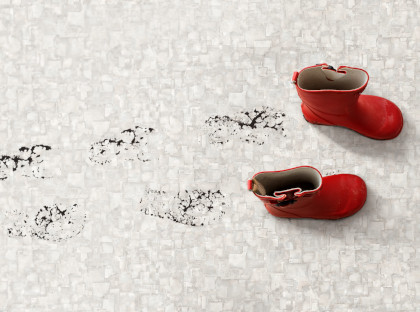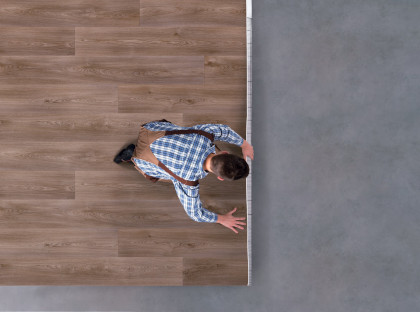Laying of PVC floor coverings
Laying vinyl flooring is easier than any other floor material. However, it requires certain skills in surface preparation, layout, trimming of linoleum and gluing it. Of course, it is better to entrust the installation to specialists who have experience in carrying out this type of finishing work, but if you want to do it yourself, then you must follow the rules and recommendations listed below.
Requirements for the base
- Preparation of the floor base before laying PVC flooring must be carried out in accordance with SP 71.13330.2017 CODE OF RULES "INSULATION AND FINISHING COATINGS", SP 29.13330–2011 CODE OF RULES "FLOORS" in updated versions, in part that does not contradict the manufacturer's specifications. The floor base should be: dry, smooth, durable, clean - free of debris, sand, dust.
-
The ideal base is a self-leveling floor or a leveled concrete screed. In domestic premises, it is permissible to lay vinyl floors on a flat (without significant height differences) plank floor, on which sheets of fiberboard, high-quality plywood or OSB plates with a thickness of 6 mm or more, fixed in 15 cm increments, are laid on top. In the case of laying PVC linoleum in public spaces, the base can ONLY be a self-leveling floor or a leveled concrete screed.
IMPORTANT! It is prohibited to lay PVC linoleum on a previously laid polyvinyl chloride coating; on a base painted with oil paint; on drying oil-soaked fiberboard or plywood; on other types of bases that deform when the temperature and humidity change. Before buying glue, check how the floor base absorbs water. If the floor base absorbs water well, you can use glue for absorbent surfaces, if the floor base does not absorb water well or does not absorb at all, you need to use a special type of glue.
Unpacking
- Make sure that the color of the roll/rolls and the quantity supplied correspond to those ordered, the product has no visible damage. Do not install a PVC floor covering that has any disadvantages.
- Before installation, the vinyl coating must be unpacked in a dry room at a temperature of at least +15 °C. When transporting PVC floor coverings at ambient temperatures from 0 °C to +10 °C the rolls should be unpacked at least 24 hours later; at a temperature below 0 °C – at least 48 hours after transferring the rolls to a room with a temperature of at least +15 °C.
- The PVC floor covering in rolls must be rolled out before installation and left to lie for at least 2 days at a temperature of at least +15 °C. Places that are loosely adjacent to the base should be loaded. We recommend cutting the PVC floor covering 24 hours before installation.
Installation requirements
- Tools required for the installation of PVC coatings:
- A metal ruler or tape measure;
- Knife/scissors for cutting floor coverings;
- Cold or hot welding (during docking);
- Special paper tape (when working with cold welding);
- Spatula;
- Lapping board or roller;
- Adhesive for floor coverings.
- It is desirable to lay a PVC floor covering at room temperature from 18 °C to 27 °C.
Fitting and trimming
- Lay out the material with the pattern up so that it fits against the wall over the entire surface or goes a few centimeters onto the wall (especially important if the walls in the room are uneven).
- To cut the outer corners, press the coating to the junction point of the wall and floor, make an incision with a small (0.3–0.5 cm segment) "cross" at the bottom along the corner of the wall exactly to the floor (to prevent tears) and spread the coating apart. To cut the inner corners, gradually cut off the corner of a piece of canvas diagonally (parallel to the floor) until the material lies exactly in the corner.
- In order to accurately cut the edge, you need to press the vinyl with your hand against the wall, then draw at the bend of the canvas and gradually cut off the excess with a knife, pressing the coating against the wall with an iron ruler or a spatula. After cutting, the material should not fit closely to the wall – in order to avoid bending of the floor covering, it is necessary to leave a gap of 5-10 mm at each wall.
IMPORTANT! Make the final cut gradually. Excess material can always be cut off, but it is difficult to restore the lack.
- In order to make the seams invisible, you need to put the overlapping edges one on top of the other before combining the pattern, press the junction of the pieces with a heavy object and cut the seams through two layers at once using a metal ruler. Perform the final trimming only at the moment of gluing. Then all that remains is to remove the clippings.
Gluing
- When laying PVC, the coating must be glued to the base over the entire area, regardless of the size of the room. This procedure has a positive effect on the service life of the product.
- To apply the adhesive composition, it is necessary to wrap the cloth from the edge to the middle to open the place where the glue is applied. Apply the adhesive composition to the base and evenly distribute it over the entire area with a notched trowel: A2 (if the linoleum substrate is smooth), B1 (if the linoleum substrate is duplicated). To select the drying time of the glue after application, follow the instructions of the glue manufacturer, take into account the type of floor base. Spread out the previously bent canvas, avoiding the appearance of bubbles, compression and tension on the material. The connecting seams should be tightly pressed against each other, but avoid bending the strip. Such bending indicates that the strips of the canvas are laid incorrectly. You can use a roller for rolling, rolling the entire floor surface, except for the joint, from the middle to the edge, carefully expelling air bubbles and ensuring a complete and uniform fit of the canvas to the base. The described process must be repeated with the second (and other) parts of the canvas over the entire area of the base. Check all the connecting seams.
- It is necessary to leave the floor cloth to be glued to the base, as indicated in the glue instructions. The material must dry for at least 24 hours at an air temperature of at least +15 °C and an air humidity of no more than 70% in a room with tightly closed windows.
IMPORTANT! When choosing an adhesive, it is better to consult a specialist or follow the recommendations of the glue manufacturers, which will depend on the characteristics of the floor base, the basis of the PVC floor covering. Be sure to read the instructions from the manufacturer of the adhesive composition before using it and strictly follow the recommendations.
- Cold welding is recommended for joining two or more vinyl floor canvases, it is a guarantee of ensuring closed and tight seams. For PVC–based floor coverings, it is better to use welding types A; for floor coverings on a duplicated basis, welding type T. Before using cold welding, it is necessary to read the instructions and comply with the specified requirements.
- Seamless laying of PVC flooring is performed similarly to laying a vinyl floor with a seam, excluding operations for combining the pattern and welding the seam.
PVC wall mounting with Underfloor heating system
- PVC floor covering can be used with water and electric floor heating systems mounted in a screed with a thickness of at least 10 mm above the heating cable. We recommend that installation work be carried out in accordance with regulatory documents.
- Gradual operation of the floor heating system is recommended – a temperature regime of 15-18 °C during installation work and the next 72 hours. 72 hours after the completion of all the stages of laying the PVC floor covering, you can start increasing the temperature step by step by 5 °C per day until standard operating temperature conditions are reached, not exceeding 27 °C.
IMPORTANT! Laying of PVC floor coverings with an infrared floor heating system is prohibited.


